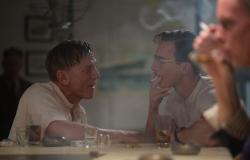(ETX Daily Up) – While some prefer to marvel at a fantasy film, others will happily choose to shiver at a horror film. Whether in series, in film, and even through immersive experiences, taking pleasure in scaring yourself is a real trend. But what really makes people appreciate these terrifying tales? A study published in the journal Scientific Reports provides some answers.
Courtesy of Paramount Pictures
It may seem surprising to some to go into the darkness of movie theaters in order to scare themselves. For researchers at the University of Pécs in Hungary, this inclination could well be explained by the excitement that fear itself provides.
The study “The role of excitement and enjoyment through subjective evaluation of horror film scenes”, published in the scientific journal Scientific Reports, demonstrates how curiosity about morbid subjects plays a preponderant role, as does the realism of the scenes and the intensity of the fear felt.
The study, led by Botond Kiss, a doctoral student and research assistant at the Institute of Psychology at the University of Pécs, recruited 558 participants. The latter were invited to complete online questionnaires on their film viewing habits, their emotional regulation, their curiosity about morbid subjects, their beliefs in the supernatural, their sensitivity to disgust and their personality traits linked to the search for sensations
Participants then viewed ten short scenes from different subgenres of horror films, ranging from supernatural to psychological to monster films. After each scene, they rated their experiences in terms of excitement, pleasure, fear, disgust, and realism.
Fear and realism as aphrodisiacs
The study results are revealing. Feelings of fear, realism of scenes, and curiosity about morbid topics are all strong predictors of excitement and pleasure. In other words, for the latter, the more realistic these films are, the more exciting and entertaining they are. Fear, in particular, is particularly associated with excitement and pleasure.
Conversely, scenes that evoke strong disgust tend to reduce pleasure in the viewer but without necessarily weakening excitement. “Previous approaches did not distinguish between pleasure and arousal,” Botond Kiss told PsyPost. “In contrast, our current research suggests that, although they are similar concepts, they are influenced by different factors. Pleasure is more influenced by perceived disgust, while arousal is more influenced by perceived fear.”
The study took the opportunity to debunk a well-established cliché. No, horror movie fans are not necessarily thrill-seekers. No matter your personal beliefs in the supernatural, your sensitivity to disgust, these parameters also did not seem to influence viewers’ reactions: “As some consumers of horror films can be described as thrill-seekers, they feel the fear-induced adrenaline as a reward. This seems to have an indirect effect on other factors,” Botond Kiss told PsyPost.
It is still important to note the limitations of this study. Most of the participants were fans of horror films, therefore already having an appetite for this genre.
“In this research, we looked at direct effects. So if one factor had an effect through another factor, we couldn’t detect it. This would require more complex analyses,” Kiss explained. “Moreover, the content of different horror film genres is very different. Think about the difference between a psychological horror film and a zombie film. In the future it might be useful to take this into account.”
“Our direct long-term plan is to identify some motivations for why people consume this type of content,” Kiss said. “Indirectly, we have the opportunity to identify the factors that influence the perception of disgust and fear. This could be important for understanding specific phobias where fear and disgust are particularly important (e.g. animal phobias or injury-injection phobias).”
Relax





